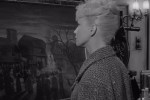Kevin Cooney
H.P. Lovecraft traveled the world without leaving Providence, Rhode Island. Knowledge of riots, famines, scientific breakthroughs, and fresh archaeological discoveries came to the New Englander via America’s flourishing newspaper industry. From that flood of information – often forwarded by fellow writers – Lovecraft wove stories from his fear-filled weltanschauung. I contend that Lovecraft leveraged fictional press “clippings” or “cuttings” as a form of “found footage.” Undervalued as an epistolary device, dramatized newspaper clips infuse Lovecraft’s The Call of Cthulhu (1928), a story of alien gods and human madness. Using an unseen “clipping bureau” in narrative service, Lovecraft harnesses the press cutting’s decontextualization of news to reshape reality into fictional symptoms of a broader, psychic panic. Through found footage, the writer, who never saw most of the world he wrote about, reinforced his fiction and his own disquieted mindset.
It is impossible to write a single paragraph about H.P. Lovecraft and not address his racism. Lovecraft’s ugly language and beliefs appear in his fiction, exemplified especially by “The Horror at Red Hook” (1925) as well as his many personal letters. Current opinions of Lovecraft are mainly bifurcated between “man of his time” advocators or those who seek his total expunging from the canon of weird literature. There is also a careening middle ground of readers who constantly wrestle with the man’s ugly beliefs and astounding creations. Efforts to complete a picture of Lovecraft reveal a casually racist, equally nihilist figure. A man who could create the impossible with words, Lovecraft was, in many ways, remarkably unworldly. Lovecraft knew the world through antiquarian books and contemporary newspapers, with his actual travel confined to eastern Canada and the United States. Retrograde opinions of society and race emerged, in particular, each time Lovecraft was confronted by cultural change. When physically put into multicultural places new or ‘exotic’ to his New England provincialism, he recoiled and retreated, leaving with a still darker and more malignant opinion. Lovecraft disliked or feared most experiences, people, or tastes of life outside Providence. As Maurice Levy points out, for Lovecraft, “ever faithful to the ideologies of the past, any infringement of the strictest segregation ends in disastrous, in monstrous, consequences” (61). His fiction, typified by Cthulhu, reveals a creative longing to explore and, like his letters, showed a fear-addled mind that desired knowledge but warned of wandering too far in its pursuit. That is why I see newspaper clippings as an important tool in The Call of Cthulhu – as a narrative device that extends his fear-filled opinions of humanity.
The Call of Cthulhu emerges from the fictional found papers of Francis Wayland Thurston, who, dispatched to Rhode Island to sift through the writings of his deceased grand-uncle George Gammell Angell, unravels the mystery of the eldritch god, Cthulhu. Told in three parts – “The Horror in Clay,” “The Tale of Inspector Legrasse,” and “The Madness from the Sea” – Cthulhu takes epistolary form as letters, manuscripts, and newspaper clippings. “The Horror in Clay” covers Angell’s interaction with a young Rhode Island sculptor’s nightmarish visions. “The Tale of Inspector Legrasse” chronicles Angell’s 1908 interaction with a New Orleans police inspector who uncovered a Cthulhu cult. The final section, “The Madness from the Sea,” sees Thurston travel to Norway to discover that the monstrous cephalopod god existed beyond fever dreams. With such a globe-spanning selection of news, the young executor concludes that his uncle “must have employed a cutting bureau, for the number of extracts was tremendous and the sources scattered throughout the globe” (174). The newspaper clipping, as an object of ephemera, is leveraged by Lovecraft to inform and tantalize the reader. Cthulhu’s creation, in short, acknowledged the narrative power of the new business- industrial-scale culling of articles.
Cutting bureaus emerged in the late nineteenth century from the collection activities of individual newspaper editors. Bureaus could scan 120 million words daily (Popp 428), with individual clippers, almost always young women, examining 60 newspapers per shift (Fraser 25). Packets of carefully clipped and keyword-highlighted articles were sent in the thousands to clients ranging from politicians to corporations, writers, and scientists. What Thurston discovers in his uncle’s press cuttings suggests increasingly inexplicable phenomena: “Here was a nocturnal suicide in London… A dispatch from California describes a theosophist colony as donning white robes en masse for some ‘glorious fulfillment’ which never arrives, whilst items from India speak guardedly of serious native unrest toward the end of March… New York policemen are mobbed by hysterical Levantines on the night of March 22–23… A weird bunch of cuttings, all told” (174). Each article appears as an isolated event, disconnected by geography until Lovecraft reveals that coincidences run out in the shadow cast by Cthulhu. I see in Cthulhu what Ellen Garvey identified as a clipping bureau’s power “that it detached clippings from their previous context and freed them to move into multiple new contexts” (236). Lacing Cthulhu with decontextualized real-world inspirations freed Lovecraft to explore the surreal and, in the process, turn basic epistolary formulas into found footage.
As the facilitator of news decontextualization and conjuror of found footage, the cutting bureau aids in Lovecraft’s fabrication of clippings to embrace found footage’s power to realize the improbable. Lovecraft’s contemporary newspapers might have a front page covered in dozens of stories, textually dense beneath bold, dramatic headlines. The fictional newspaper clipping served as a narrative device with real-world analogs, then, blurring the line between real and imagined threats. A trio of newspaper headlines contemporary to Cthulhu reveals reality’s easy drift into fiction. Mirroring Lovecraft’s imagined California Theosophists awaiting a transcendent hapening in Cthulhu was a December 1925 report in Washington D.C.’s Evening Star describing an eerily similar California event: “Cult Awaits New Advent of Christ- Theosophists Prepare to Greet Messiah” (“Cult Awaits”). Similarly, an earthquake that roiled the earth in Cthulhu was potentially inspired by a March 1925 quake reported by the Daily Kennebec Journal as ” Earthquake Started in ‘Fault’ Under Gulf of Maine” (“Says Earthquake”). Cthulhu’s riots in British-occupied India might be traced to similar stories throughout American newspapers, like the “Many Killed During Riots in Calcutta” in an April 3, 1926, edition of The Bismarck Tribune (“Many Killed”). We know Lovecraft immersed himself in newspaper clippings through the frequent letters he exchanged with friends and writers, many acting as an informal clipping bureau. Poet Elizabeth Toldridge frequently plied Lovecraft with odd articles like news of Colorado laborers’ discovery of a 20,000-year-old skeleton (“Find Camel Bones.”) In a 1936 letter to Clark Ashton Smith, Lovecraft included an authentic clipping that could have come straight from Cthulhu, in which an unknown wire service reporter claimed that an anthropologist had searched Alaska for alleged cannibals (“Finds No Cannibals”). If the clippings received or created by Lovecraft are exemplars of odd or weird articles passing over the writer’s desk, we also need to understand that the published news of the day was disturbingly close to, if not in excess of, Lovecraft’s bigotry.
Amid the cuttings of The Call of Cthulhu, a handful leap from the page as loathsome to our modern view. One example of this prejudice emerges in Lovecraft’s treatment of the African diasporic religion, voodoo. Among the numerous reports of incidents found in Angell’s belongings, Lovecraft includes a description indicating that Cthulhu’s psychic disturbance was causing “Voodoo orgies” to multiply in Haiti (174). In “The Tales of Inspector Legrasse,” the eponymous inspector discovers a Cthulhu cult in the swamps of Louisiana, “more diabolic than even the blackest of the African voodoo circles” (175). Adherents, called “hybrid spawn” and “mongrel celebrants” (180), encircle the alien god’s effigy until Legrasse’s men converge and arrest the lot. The nine-year occupation of Haiti by the United States provided ample racist material for American newspaper readers and inspiration for Lovecraft. A 1922 edition of The New York Herald filled a page with ‘news’ beneath a racist illustration and grotesque declaration, “How I Helped the Voodoo Priest Slay his Victims” (“How I Helped”). The same year, several newspapers, including the Dakota County Herald, reported that “Voodooism is Faith of Haiti,” claiming that followers “Kill Humans, Drink Blood” (“Voodooism is Faith”). Playing off this ugly racist “journalism,” Lovecraft’s fictional newspaper clippings amplified his weird fiction by engaging the contemporary reader’s familiarity with openly bigoted news copy.
Lovecraft’s found press cuttings forge two types of startling worlds – the cosmic weird and the bigoted real. To the 1920s reader of fantastic fiction, Lovecraft’s conjuring of the “dead Cthulhu waits dreaming” was a leap into the deep unknown called cosmic horror. Yet, we cannot overlook Lovecraft’s ability to engage readers with a decidedly racist unknown “reality.” By mimicking the biased news reporting of the period, Lovecraft transformed glimpses of remote cultures into grotesquely real clippings. Building on that ability to bend or confuse reality, Lovecraft intertwined found clippings believably as he “understood the power of the citation, the way in which a text seems more real if it is cited than if it is encountered in the raw” (Fisher 24).
Found footage relies on direct observation of places – the camera recording. For The Blair Witch Project (1999) to work, all one needs is to watch the camera’s point-of-view shakily capture familiar yet strange locations. The viewer, in this case, is observing directly. Lovecraft’s fantastic and fictionalized newspaper clippings, however, employ indirect observations as found footage. Rather than hailing the reader as a direct observer, Lovecraft uses fictional journalists and editors to put distance between the incident and the reader. Video footage of a creature skulking in the woods is firsthand information. Lovecraft’s found footage is third-hand, distilled information. If found footage images scream a malevolent reality, press clippings whisper from a distance. But in that whisper comes a dreadful plausibility anticipating reality to come. Cecilia Sayad’s observation that found footage was “not a mere artifact but a fragment of the real world, and the implication is that its material might well spill over into it” (45) immediately brings to mind the role of clippings in The Call of Cthulhu. By fragmenting reality into scraps and weaving them through an obvious work of fiction, Lovecraft balanced and then exploited weird fiction’s ability to ‘inform’ and ‘subvert,’ tipping the story into a quasi-reality. Testament to the effectiveness of blending fact and fiction is his creation of the dark magic grimoire, the Necronomicon. Said to be housed at Harvard University’s Widener Library, the book is actually believed by some Lovecraft devotees to sit on the library’s dusty cast-iron shelves.
Refashioning small doses of biased reporting, Lovecraft could ‘inform’ to build credibility and then subvert ‘reality’ with impossible ideas, beings, or creatures – things that seeped between the cracks of reality. While Lovecraft’s tales of dark New England stream from his antiquarian core, his brushes with full-fledged modernity, like The Call of Cthulhu, required and relied on the news of the day to sell ‘reality.’ And during the first decades of the twentieth century, Lovecraft did not have to look far to find inspiration of the ugliest sort. Lovecraft’s disassembled, fabricated, and yet eerily familiar cuttings flowed into the readers’ minds, and they in turn reassembled mental scrapbooks of found clippings that suggested the weird and cataclysmic was waiting to bleed into their world.
Works Cited
“Cult Awaits New Advent of Christ.” The Evening Star [Washington, DC], 16 Dec. 1925. Library of Congress, https://chroniclingamerica.loc.gov/lccn/sn83045462/1925-12-16/ed-1/seq-19/. Accessed 10 Nov. 2022.
“Find Camel’s Bones- 20,000-Year-Old Skeleton Uncovered by Denver Workmen.” 8 July 1935. Brown University Digital Repository. Newspaper clipping. Howard P. Lovecraft Collection. https://repository.library.brown.edu/studio/item/bdr:937656/. Accessed 10 Nov. 2022.
“Find No Cannibals in Alaskan Search.” 29 Sept. 1936. Brown University Digital Repository. Providence, RI. Newspaper clipping. Howard P. Lovecraft Collection. https://repository.library.brown.edu/studio/item/bdr:927298/. Accessed 10 Nov., 2022.
Fisher, Mark. The Weird and the Eerie. Repeater Books, 2016.
Fraser, Alison. “Mass Print, Clipping Bureaus, and the Pre-Digital Database: Reexamining Marianne Moore’s Collage Poetics through the Archives.” Journal of Modern Literature, vol. 43, no. 1, 2019, pp. 19–33, https://doi.org/10.2979/jmodelite.43.1.02.
Garvey, Ellen Gruber. Writing with Scissors: American Scrapbooks from the Civil War to the Harlem Renaissance. Oxford University Press, 2013.
“How I Helped the Voodoo Priest Slay his Victims.” The New York Herald, 14 May 1922. Library of Congress, https://chroniclingamerica.loc.gov/lccn/sn83045774/1922-05-14/ed-1/seq-90/. Accessed 20 Dec. 2022.
Lévy, Maurice. Lovecraft, a Study in the Fantastic. Wayne State University Press, 1988.
Lovecraft, H. P. Tales. Library of America, 2005.
“Many Killed During Riots in Calcutta.” The Bismark Tribune [Bismark, S.D.], 3 Apr. 1926. Library of Congress, https://chroniclingamerica.loc.gov/lccn/sn85042243/1926-04-03/ed-1/seq-1/. Accessed 10 Nov. 2022.
Popp, R. K. “Information, Industrialization, and the Business of Press Clippings, 1880-1925.” The Journal of American History, vol. 101, no. 2, 2014, pp. 427–53, https://doi.org/10.1093/jahist/jau373.
Sayad, Cecilia. “Found-Footage Horror and the Frame’s Undoing.” Cinema Journal, vol. 55, no. 2, 2016, pp. 43–66, https://doi.org/10.1353/cj.2016.0003.
“Says Earthquake Started in ‘Fault’ Under Gulf of Maine.” Daily Kennebec Journal.” 2 March 1925, Library of Congress, https://chroniclingamerica.loc.gov/lccn/sn82014248/1925-03-02/ed-1/seq-2/. Accessed 10 Nov. 2022.
“Voodooism is Faith of Haiti.” Dakota County Herald [Dakota City, Neb.], 6 Jan. 1922. Library of Congress, https://chroniclingamerica.loc.gov/lccn/2010270500/1921-01-06/ed-1/seq-6/ Accessed 21 Dec. 2022.







